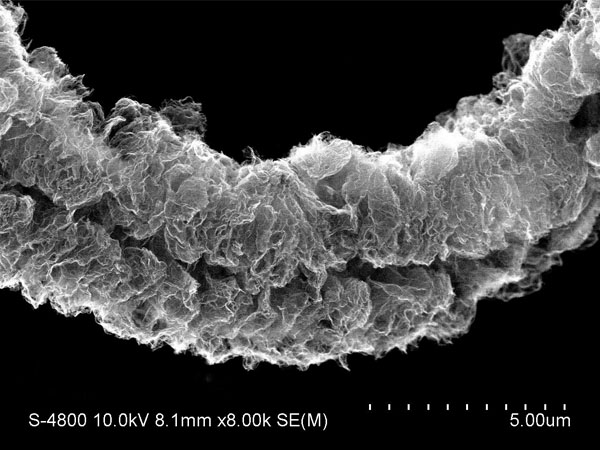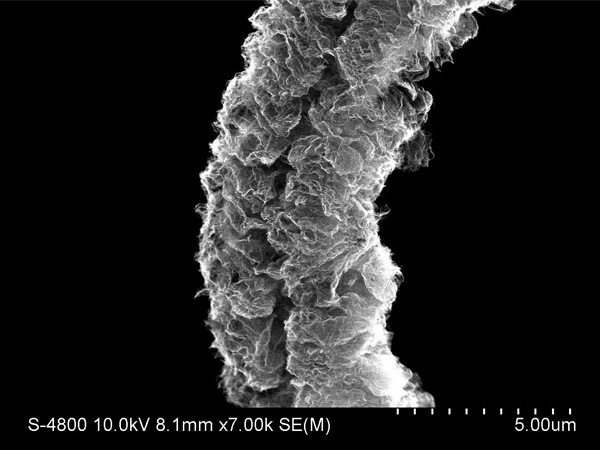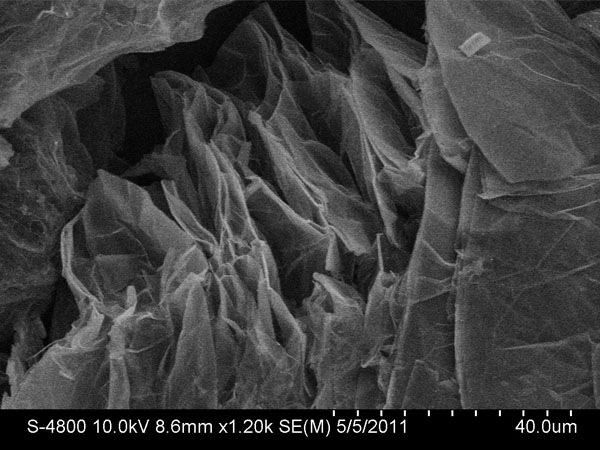Expandable Graphite
Product Detail
Expandable graphite from ACS Material is a specially synthesized intercalation compound of graphite. Graphite’s flaky, layered structure makes it possible to introduce outside atoms or small molecules between the graphite layers. This process is called intercalation and the result is an expandable graphite salt or a graphite intercalation compound (GIC.) The material gets its name because, when exposed to heat, the intercalated graphite layers expand and separate like an accordion. The final expanded volume can be hundreds of times greater than the initial volume of the material. The intercalation agent and the proportion of intercalated layers determine the temperature at which expansion begins and the rate at which expansion occurs.
Expansion of the flake graphite decreases the material’s overall bulk density while increasing its surface area; this change yields a material that demonstrates increased chemical reactivity over the original material. Expandable graphite is valued as a flame retardant. Expansion creates an intumescent layer on the surface of the graphite flake that slows the spread of fire and minimizes the creation of toxic fumes and gases.
Expandable graphite is also a component in a number of additional applications, including:
- Batteries
- Coatings
- Plastic foils
- Rubber products
- Heating and cooling systems
- Energy storage systems
- Sealing systems
- And many others
New Products List
|
SKU |
Particle Size |
Purity (%) |
Expansion Start Temperature (EST‚ °C) |
Expansion Volume (EV‚ ml/g) |
Highlights and Application |
|
CXG22022 |
80%<75um |
≥92% |
190℃±10℃ |
≥20 ml/g |
Application: Coatings, Paints, Adhesive, and Textile, which requires finer particle size. |
|
CXG21122 |
80%<150 um |
≥94% |
180℃±10℃ |
≥35 ml/g |
Application: Coatings, Paints, Adhesive, and Textile, which requires finer particle size, in case CXG22022 cannot satisfy the flame retardance requirements. |
|
CXG21222 |
80%<150 um |
≥94% |
180℃±10℃ |
≥95 ml/g |
Application: Coatings, Paints, Adhesive, and Textile, which requires finer particle size, in case CXG21122 cannot satisfy the flame retardance requirements. |
|
CXG52322 |
80%>150 um |
≥95.0% |
180℃±10℃ |
≥200 ml/g |
Application: Spray foams, which require fine particle size. |
|
CXG8B122 |
80%>180 um |
≥95.0% |
180℃±10℃ |
≥230 ml/g |
Standard product with fine particle size. Application in PU foam, EPS foam, Sealing Strip, etc. |
|
CXG5B122 |
80%>300 um |
≥95.0% |
180℃±10℃ |
≥250 ml/g |
Standard product for all main applications, like PU foam, Coating, Rubber, Adhesive, Construction Materials, etc. |
|
CXG5B022 |
80%>300 um |
≥99.0% |
180℃±10℃ |
≥250 ml/g |
Same expansion, but higher purity than CXG5B122 |
|
CXG5C022 |
80%>300 um |
≥98.0% |
170℃±10℃ |
≥350 ml/g |
High purity, very high free expansion and expansion strength. Application: for all main applications which requires better flame-retardant effects than CXG5B122. |
| SKU |
Mesh |
Purity (%) |
Expansion Start Temperature (EST,°C) |
Expansion Volume (EV, ml/g) |
Highlights and Application |
| *CXGAA222 |
150 |
≥92% | 175℃ | ≥150 ml/g | Mainly used in fabric coatings, fire-resistant adhesives and EPS and XPS flame retardants |
| *CXG00522 |
80 |
≥95% | 250℃ | ≥180 ml/g |
With application where extruder used |
| *CXG00622 |
50 |
≥95% | 300℃ | ≥170 ml/g | Highest Expansion Start Temperature |
*These three products will be discontinued after sold out.
Please also take a look at our Lower Temperature Expandable Graphite.
| Products No. |
Expansion Start Temperature (EST‚ °C) |
pH | Mesh |
Packing Density (mg/cm3) |
Expansion Volume (EV‚ ml/g) |
Property |
| 110 | 7.0 | 80 | 0.6 | 230 |
Super-low Expansion Start Temperature |
|
| 150 | 7.0 | 80 | 0.6 | 230 |



Disclaimer: ACS Material LLC believes that the information on our website is accurate and represents the best and most current information available to us. ACS Material makes no representations or warranties either express or implied, regarding the suitability of the material for any purpose or the accuracy of the information listed here. Accordingly, ACS Material will not be responsible for damages resulting from use of or reliance upon this information.
Research Citations of ACS Material Products
- Meduri, Kavita. "Carbon-Supported Transition Metal Nanoparticles for Catalytic and Electromagnetic Applications." (2018).
- Meduri, Kavita, Candice Stauffer, Wen Qian, Otto Zietz, Andrew Barnum, Graham O’Brien Johnson, Dimin Fan et al. "Palladium and gold nanoparticles on carbon supports as highly efficient catalysts for effective removal of trichloroethylene." Journal of Materials Research 33, no. 16 (2018): 2404-2413.

